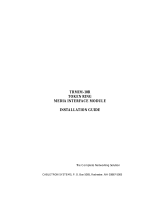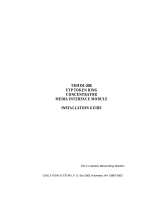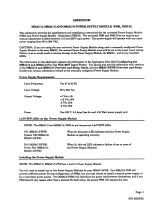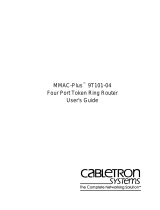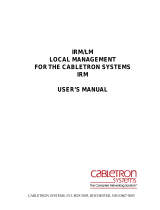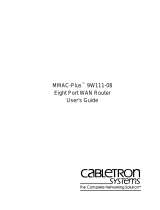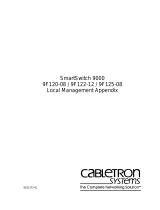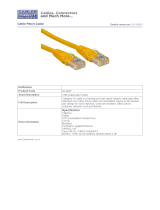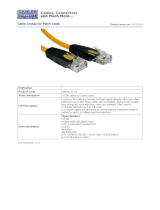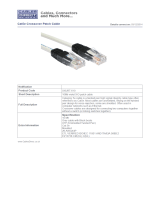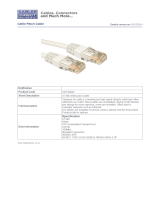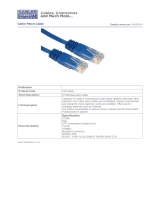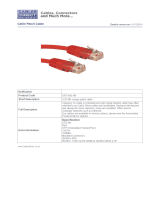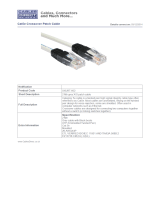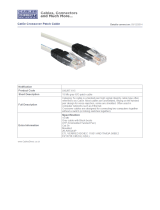Page is loading ...

CABLETRON SYSTEMS, P.O. Box 5005, Rochester, NH 03867-0505
TRMIM-22/24/42/44
TOKEN RING
MEDIA INTERFACE MODULES
INSTALLATION GUIDE

NOTICE
i
NOTICE
Cabletron Systems reserves the right to make changes in
specifications and other information contained in this document
without prior notice. The reader should in all cases consult Cabletron
Systems to determine whether any such changes have been made.
The hardware, firmware, or software described in this manual is
subject to change without notice.
IN NO EVENT SHALL CABLETRON SYSTEMS BE LIABLE FOR
ANY INCIDENTAL, INDIRECT, SPECIAL, OR CONSEQUENTIAL
DAMAGES WHATSOEVER (INCLUDING BUT NOT LIMITED TO
LOST PROFITS) ARISING OUT OF OR RELATED TO THIS
MANUAL OR THE INFORMATION CONTAINED IN IT, EVEN IF
CABLETRON SYSTEMS HAS BEEN ADVISED OF, KNOWN, OR
SHOULD HAVE KNOWN, THE POSSIBILITY OF SUCH
DAMAGES.
Copyright October 1992 by:
Cabletron Systems, Inc.
P.O. Box 5005
Rochester, NH 03867-0505
All Rights Reserved
Printed in the United States of America
Order Number: 9030257-02 October 92
FNB, Multi Media Access Center, Remote LANVIEW and
LANVIEW are registered trademarks of Cabletron Systems, Inc.
TRRMIM-A, TRRMIM-2A, TRRMIM-4A, TRMIM-22, TRMIM-24,
TRMIM-42, TRMIM-44, Flexible Network Bus and MMAC are
trademarks of Cabletron Systems, Inc.
IBM is a registered trademark of International Business Machines
Corporation.

FCC NOTICE
ii
FCC NOTICE
This device complies with Part 15 of FCC rules. Operation is subject
to the following two conditions: (1) this device may not cause harmful
interference, and (2) this device must accept any interference re-
ceived, including interference that may cause undesired operation.
NOTE: This equipment has been tested and found to comply with
the limits for a Class A digital device, pursuant to Part 15 of FCC
Rules. These limits are designed to provide reasonable protection
against harmful interference when the equipment is operated in a
commercial environment. This equipment uses, generates, and can
radiate radio frequency energy and if not installed in accordance with
the operator’s manual, may cause harmful interference to radio
communications. Operation of this equipment in a residential area is
likely to cause interference in which case the user will be required at
his own expense to correct the interference.
If this equipment does cause interference to radio or television, which
can be determined by turning the equipment off and on, the user is
encouraged to try to correct the interference by one or more of the
following measures:
• Re-orient the receiving antenna.
• Relocate the equipment with respect to the receiving antenna.
• Move the equipment away from the receiver.
• Plug the equipment into a different outlet so that the equipment
and the receiver are on different branch circuits.
If necessary, the user should consult the dealer or an experienced
radio/ television technician for additional suggestions. The user may
find the following booklet prepared by the Federal Communication
Commission helpful:
“Interference Handbook”
This booklet is available from the U.S. Government Printing Office,
Washington D.C. 20402 - Stock No. 004-000-00482-5.

Page 1-1
INTRODUCTION
CHAPTER 1
INTRODUCTION
Welcome to the Token Ring Media Interface Modules
Installation Guide. This manual serves as a reference for installing
and troubleshooting Cabletron Systems TRMIM-22, TRMIM-24,
TRMIM-42, and TRMIM-44.
The TRMIM-22, TRMIM-24, TRMIM-42, and TRMIM-44 comprise a
family of Token Ring Concentrator modules. The TRMIM-22 and
TRMIM-24 provide 12 and 24 trunk coupling unit (TCU) ports,
respectively, that support voice grade unshielded twisted pair (UTP)
cabling. The TRMIM-42 and TRMIM-44 have 12 and 24 TCU ports,
respectively, supporting IBM
type 1, 2, 6, and 9 shielded twisted pair
(STP) cabling.
Both UTP concentrator modules and both STP concentrator modules
are equipped with RJ-45 modular connectors. The STP concentrator
module RJ-45 connectors provide for connection of the cabling shield.
All four concentrator modules are designed for installation in any
Cabletron Systems Multi Media Access Center
(MMAC) equipped
with a Flexible Network Bus (FNB
). All four concentrator
modules are IEEE 802.5 compliant and compatible with IBM
products.
NOTE: The term Concentrator Module is used throughout this
manual when describing features and functions that are common to
the TRMIM-22, TRMIM-24, TRMIM-42, and TRMIM-44. The terms
TRMIM-22, TRMIM-24, TRMIM-42, and TRMIM-44 are used when
it is necessary to describe features that are unique to any device.
1.1 USING THIS MANUAL
Prior to installing and operating your concentrator module, read
through this manual completely to familiarize yourself with its
contents and to gain an understanding of the features of the
concentrator module.
A general working knowledge of Token Ring (IEEE 802.5) networks
will be helpful when installing your concentrator module.

Page 1-2
INTRODUCTION
Chapter 1, Introduction, describes how to use this document,
provides an overview of the features and capabilities of each
concentrator module, and concludes with a list of related manuals.
Chapter 2, Installation Requirements/Specifications, lists the
network requirements that must be met before you begin installing
your concentrator module. Detailed specifications for each of the
concentrator modules is also provided.
Chapter 3, Installing the Concentrator Module, contains
instructions for installing a concentrator module into the MMAC, and
attaching token ring station cabling.
Chapter 4, Testing and Troubleshooting, describes checks that
you can perform if you encounter problems after installing a
concentrator module. Instructions for using LANVIEW
, Cabletron
Systems’ built-in visual diagnostic and status monitoring system, are
also included.
1.2 THE CONCENTRATOR MODULES
The TRMIM-22, TRMIM-24, TRMIM-42, and TRMIM-44, shown in
Figure 1-1, can be installed as a free standing token ring network or
to provide UTP or STP connectivity to an existing token ring network.
All four concentrator modules are designed for installation into a
Cabletron Systems MMAC. Since they do not have externally
accessible Ring-In and Ring-Out ports, they are considered
concentrator modules. (A concentrator in token ring applications is
defined as a device with multiple TCU ports bounded by externally
accessible Ring-In and Ring-Out ports.)
All four concentrator modules are designed for installation into a
Cabletron Systems MMAC, where they can be used to create an
independent 12 or 24 port ring or to expand an existing token ring
network. When any concentrator module is used within an MMAC,
the concentrator module is connected through the MMAC backplane
via the Flexible Network Bus (FNB) to other token ring MIMs,
repeaters, bridges, or management modules.
The MIMs automatically attach to each other through the FNB when
positioned in adjacent slots and configured with identical ring speed
settings.

Page 1-3
INTRODUCTION
Figure 1-1. The TRMIM-22, TRMIM-24, TRMIM-42,
and TRMIM-44 Token Ring Concentrator Modules
Features of the concentrator module include:
Number of Connections
• TRMIM-22 12 - Unshielded RJ-45 ports
• TRMIM-42 12 - Shielded RJ-45 ports
• TRMIM-24 24 - Unshielded RJ-45 ports
• TRMIM-44 24 - Shielded RJ-45 ports
Multiple concentrator modules can be installed into an MMAC to
increase the number of UTP/STP ports available on a token ring
network.
TRMIM-22
UTP
TOKEN RING
7
X
8
X
9
X
10
X
11
X
12
X
SN
1
X
2
X
3
X
4
X
5
X
6
X
TRMIM-24
UTP
TOKEN RING
7
X
8
X
9
X
10
X
11
X
12
X
13
X
14
X
15
X
16
X
17
X
18
X
19
X
20
X
21
X
22
X
23
X
24
X
SN
1
X
2
X
3
X
4
X
5
X
6
X
5
X
TRMIM-42
STP
TOKEN RING
7
X
8
X
9
X
10
X
11
X
12
X
SN
1
X
2
X
3
X
4
X
6
X
4
X
5
X
TRMIM-44
STP
TOKEN RING
7
X
8
X
9
X
10
X
11
X
12
X
13
X
14
X
15
X
16
X
17
X
18
X
19
X
20
X
21
X
22
X
23
X
24
X
SN
1
X
2
X
3
X
6
X

Page 1-4
INTRODUCTION
Multiple Concentrator Modules
Several concentrator modules can be installed into a single MMAC
and configured as independent rings or linked together into a single
ring network. Configuration guidelines can be found in Chapter 3,
Installing the Concentrator Module.
Multiple MMACs in a Ring Network
Several MMACs can be connected into the same ring network by
installing token ring concentrators (TRMIM-10R/20R with externally
accessible Ring-In/Ring-Out ports) or token ring repeaters
(TRRMIM-A/2A/4A). The choice between using concentrators or
repeaters depends on specific network configurations. Refer to
Cabletron Systems TRMIM-10R/20R Installation Guide or
TRRMIM-A/2A/4A Installation Guide for more information on the
use of these products or contact Cabletron Systems Technical
Support.
A variety of network management tools can be used to control and
monitor these repeaters, including Cabletron Systems Local
Management, Remote LANVIEW
/Windows, and SPECTRUM
.
LANVIEW LEDs
Several LEDs, on the front panel of the concentrator module, are used
to indicate the ring speed, a bypass condition, status, and
management statistics for each of the TCU ports. LANVIEW is an
effective tool to help you quickly diagnose your physical layer network
problems.

Page 1-5
INTRODUCTION
1.3 RELATED MANUALS
The manuals listed below should be used to supplement the
procedures and other technical data provided in this manual. The
procedures in them will be referenced, where appropriate, but will not
be repeated.
Cabletron Systems Multi Media Access Center Overview and Set
Up Guide
Cabletron Systems TRRMIM-A, TRRMIM-2A, & TRRMIM-4A
Token Ring Repeaters Installation Guide
Cabletron Systems TRMIM-10R STP Token Ring Concentrator
Installation Guide
Cabletron Systems TRMIM-12 Token Ring Media Interface
Module Installation Guide
1.4 RECOMMENDED READING
The following publications are recommended if more information is
required on implementing a token ring network.
Local Area Networks, Token Ring Access Method, IEEE
Standard 802.5 (1989)
Commercial Building Wiring Standard, EIA Standard
Proposal No. 1907-B (if approved, to be published as EIA/TIA-568)
LAN Troubleshooting Handbook, Mark Miller (1989, M&T
Publishing)

Page 1-6
INTRODUCTION
1.5 GETTING HELP
If you need additional support related to the Cabletron Systems
Token Ring products, or if you have any questions, comments or
suggestions related to this manual, contact Cabletron Systems
Technical Support at:
Cabletron Systems
P. O. Box 5005
Rochester, NH 03867-0505
Phone: (603) 332-9400

REQUIREMENTS/SPECIFICATIONS
Page 2-1
CHAPTER 2
INSTALLATION
REQUIREMENTS/SPECIFICATIONS
Before you attempt to install your concentrator module, review the
installation requirements and operating specifications that are
outlined in this chapter.
Your network installation must meet the conditions, guidelines,
specifications, and requirements included in this chapter to obtain
satisfactory performance from this equipment. Failure to follow these
guidelines could produce poor network performance.
2.1 NETWORK REQUIREMENTS
Take care in planning and preparing the cabling and connections for
your network. The quality of the connections, the length of cables
and other conditions of the installation are critical factors in
determining the reliability of your network. Work area wall plates/
outlets used for your token ring network should be clearly labeled as
token ring network lobe connections.
The following sections describe network requirements for this
equipment.
2.1.1 Cable Specifications
The media used for station (lobe) cabling depends on your specific
concentrator module:
• The TRMIM-22 and TRMIM-24 support voice grade UTP cable, as
described in EIA Standard Proposal No. 1907-A, and IBM Type 3
UTP cabling.
• The TRMIM-42 and TRMIM-44 support IBM shielded twisted
pair (STP) cable Types 1, 2, 6, and 9 at their trunk coupling unit
(TCU) ports.

Page 2-2
REQUIREMENTS/SPECIFICATIONS
UTP CABLE TYPES
Both UTP concentrator modules (TRMIM-22 & 24) support D-inside
wiring (DIW) voice grade Unshielded Twisted Pair (UTP) cable as
described in EIA SP-1907B. Voice grade UTP cabling (e.g., IBM
Type 3 UTP) must conform to the limits shown in Table 2-1.
The increased popularity and cost advantages of UTP cable have
driven refinements to UTP cable design. As a result, better grades of
UTP cable, known as supergrade or level 4, that exhibit improved
transmission characteristics are becoming available. These improved
grades of UTP can often be used to permit operation at 16 Mbit/s on
longer lobe cables.
Table 2-1. UTP Voice Grade (IBM Type 3) Specifications
Frequency Impedance Attenuation
1 Mhz 100Ω ±15% <26 dB/km (8 dB/1000 ft)
4 Mhz 100Ω ±15% <56 dB/km (16 dB/1000 ft)
10 Mhz 100Ω ±15% <98 dB/km (30 dB/1000 ft)
16 Mhz 100Ω ±15% <131 dB/km (40 dB/1000 ft)
NOTE: IBM Type 3 - Consists of four Unshielded Twisted Pairs of 24
AWG solid wire for data or voice communication and is typically used
to wire cable runs within the walls of buildings.
In some installations, existing UTP building wiring can be used for
token ring cabling. DO NOT connect UTP cabling to any non-token
ring network conductors (telephone, etc.) or ground. If in doubt, test
wiring before using.
WARNING: Telephone Battery and Ringing voltages, used in UTP
telephone circuits, could present a shock hazard and can damage
token ring equipment when connected to token ring cabling.
Type 3 Media Filter
When connecting token ring devices that are not equipped with a
Type 3 Media Filter to either of the active UTP concentrator modules
(TRMIM-22/24), a Type 3 Media Filter, such as the Cabletron
Systems TRMF (see Figure 2-1) or TRMF-2, must be installed in line
with the lobe cable at the connection to token ring station.

REQUIREMENTS/SPECIFICATIONS
Page 2-3
STP CABLE TYPES
Figure 2-1. Cabletron Systems TRMF
Both STP (TRMIM-42 & 44) concentrator modules support IBM Type
1, 2, 6, and 9 STP cabling as described in Table 2-2. STP cabling
must conform to the limits shown in Table 2-3.
Table 2-2. IBM Cable Types
Type 1 Two shielded twisted pairs (STP) of 22 AWG solid wire
for data. Used for the longest cable runs within the
walls of buildings.
Type 2 Similar to Type 1 data cable, but having four
additional unshielded twisted pairs of 22 AWG solid
wire. These are carried outside of the shield casing
and are typically used for voice communication.
Frequently used to wire cable runs within the walls of
buildings.
Type 6 Two STP of 26 AWG stranded wire for data. This type
is used in patch panels or to connect devices to/from
wall jacks. Attenuation for Type 6 cable is 3/2 x Type
1 cable (66 m of Type 6 = 100 meters of Type 1).
Type 9 Similar to Type 1, but uses 26 AWG solid wire.
Attenuation for Type 9 cable is 3/2 x Type 1 cable (66
m of Type 9 = 100 meters of Type 1).
TRMF
802.5 MEDIA FILTER
WITH LANVIEW

Page 2-4
REQUIREMENTS/SPECIFICATIONS
Attenuation and Impedance
The maximum attenuation for specific STP cable types is shown in
Table 2-3. The attenuation values include the attenuation of the
cables, connectors, patch panels, and reflection losses due to
impedance mismatches in the segment.
Table 2-3. STP Cable Specifications
Frequency Impedance Attenuation
Types 1 & 2
4 Mhz 150Ω ±15% <22 dB/km (6.7 dB/1000 ft)
16 Mhz 150Ω ±15% <45 dB/km (13.7 dB/1000 ft)
Types 6 & 9
4 Mhz 150Ω ±15% <33 dB/km (10 dB/1000 ft)
16 Mhz 150Ω ±15% <66 dB/km (20 dB/1000 ft)
Cable Lengths to Stations
The physical length of the cable connecting a station to the trunk
coupling unit (TCU) port on the concentrator module is referred to as
lobe length. The maximum lobe length attainable, under ideal
conditions, with the concentrator module is shown in Table 2-4.
Cable routing, connector attenuation, noise and crosstalk can
adversely influence the maximum lobe length.
Table 2-4. Maximum Lobe Length
Maximum Lobe Length
Cable Type 4 Mbit/s 16 Mbit/s
TRRMIM-22/24
Voice Grade UTP 200 meters 100 meters
(or IBM Type 3) (656 feet) (328 feet)
TRRMIM-42/44
STP (IBM Types 1 & 2) 300 meters 150 meters
(984 feet) (492 feet)
STP (IBM Type 6 &9) 200 meters 100 meters
(only for station to wall (656 feet) (328 feet)
jack and patch panels)

REQUIREMENTS/SPECIFICATIONS
Page 2-5
Mixed Cable Types - If you mix cable types in your installation, you
must compensate for the different cable attenuations. Type 6 and
Type 9 cables can be run for only 2/3 the distance of Type 1. This
means:
10 meters (Type 1) ≈ 6.6 meters (Types 6, 9)
Sample Problem: Determine the maximum length for mixed
cabling installation
— 16 Mbit/s ring speed and 130 stations.
— The building has 60 meters of Type 1 cable in the wall.
— What is the length of Type 6 cable available to connect from the
TCU port to the patch panel and from the local wall jack to the
station?
— Type 6 can only go 2/3 the distance of Type 1.
Solution:
100 meters = maximum cable length if only Type 1 cable is used
[60 meters of Type 1] + [40 meters of Type 1] = max. length
[60 meters of Type 1] + [(0.66) x (40 meters) of Type 6] = max.
length
|
|
26.4 meters of Type 6
(for patch panel and wall jack connections)
2.1.2 Cabling Recommendations
Crosstalk, noise, and the number and quality of connections
determine reliable data propagation and your network’s error rate.
Crosstalk is interference caused by signal coupling between the
different cable pairs contained within a multi-pair cable bundle.
Multi-pair cables should not be used for UTP lobe cabling. STP lobe
cabling should be dedicated to carrying token ring traffic. Avoid
mixing token ring signals with other applications (voice, etc.) within
the same cable.
Noise can be caused by either crosstalk or externally induced
impulses. If noise induced errors are suspected, it may be necessary
to re-route cabling away from potential noise sources (motors,
switching equipment, fluorescent lighting, high amperage
equipment), or to ensure that the electrical wiring in the area is
properly wired and grounded.

Page 2-6
REQUIREMENTS/SPECIFICATIONS
In addition to complying with the preceding cable specifications, the
following recommendations should be followed to minimize errors and
help to obtain optimum performance from your network:
• UTP cabling should be free of splices, stubs or bridged taps.
• No more than two punch-down blocks between TCU ports and
wall outlets.
• Metal troughs, ducts, etc. carrying token ring signals should
be properly grounded.
• Route cables away from sources of electrical noise, such as:
- Power lines
- Fluorescent lights
- Electric motors
- Radio interference
- Heavy machinery.
• Do not use UTP as main trunk cabling.
• Token ring signals should not be routed through UTP cables
that exit a building or which are adjacent to cables either
exiting a building or exposed to lightning strikes and power
surges.
• UTP cables that contain token ring signals should not be
simultaneously used for applications which may impress high
voltages (greater than 5 volts) with sharp rise or fall times,
since the noise coupling from such signals could directly cause
errors on the token ring network.
• For single telecommunications closet rings, lobe lengths
should not exceed 100 meters or 22 to 24 AWG wire from the
attaching device and the TCU port.
• When possible, use dedicated UTP cable for token ring
signals.

REQUIREMENTS/SPECIFICATIONS
Page 2-7
2.2 MAXIMUM NUMBER OF STATIONS
The maximum number of stations in a single ring, using STP lobe
cabling is dependent on the ring speed. At 4 Mbit/s, up to 250
stations can be connected. At 16 Mbit/s, up to 136 stations can be
connected.
When UTP lobe cabling is used anywhere on the ring, the number of
stations is limited to 72 stations, regardless of the ring speed.
2.3 OPERATING SPECIFICATIONS
This section describes the operating specifications for each of the
active token ring concentrator modules. Cabletron Systems reserves
the right to change these specifications at any time without notice.
2.3.1 Connector Types
The concentrator module TCU ports are internally crossed-over to
provide connection of station lobe cabling via female RJ-45
receptacles on the front panel. Figure 2-2 shows the pinouts required
for the mating (male) RJ-45 connectors for both UTP and STP
versions of the concentrator modules. The RJ-45 connectors (male
and female) used with the TRMIM-42 and TRMIM-44 are encased in
a metallic shield that is connected to the cable shield.
Figure 2-2. Concentrator Module TCU Port Pinouts
MALE
RJ-45
8
7
6
5
4
3
2
1
TX+
RX–
RX+
TX–
MALE
RJ-45
Trunk Coupling Unit
(TCU) Port
8
7
6
5
4
3
2
1
TX+
RX–
RX+
TX–
Cable Shield
Cable Shield

Page 2-8
REQUIREMENTS/SPECIFICATIONS
The shield continuity is maintained by contacts within the female
RJ-45 that contact the metallic casing of the male RJ-45 on the STP
lobe cabling.
Shielded patch cables that adapt a shielded RJ-45 to a Data
Connector (MIC) are available from Cabletron Systems in eight foot
lengths. These adapter/patch cables permit connecting to an existing
patch panel equipped with data connectors (see Figure 2-3).
Figure 2-3. STP Adapter/Patch Cable (PN 9420002)
2.3.2 Ring Speed
The concentrator module ring speed can be set to either 4 Mbit/s or 16
Mbit/s. The ring speed is automatically set to a default setting at
power on. The default ring speed can be selected by positioning a
network speed jumper on the board (Refer to Chapter 3, Installing
the Concentrator Module, to learn how to set the network speed
jumper.) The default setting can be overridden by changing the ring
speed through local or remote network management software.
2.3.3 Ring Order
When multiple Token Ring boards (set to the same ring speed) are
installed in adjacent slots within an MMAC, they can be attached via
the FNB to create a larger ring network. Multiple Token Ring boards
are automatically attached (when possible) at power on, but the
configuration can be modified via network management software,
attaching or detaching adjacent boards and, as a result, changing the
ring sequence.
4
5
6
3
Patch Panel/
Token Ring
Station
TX+
TX–
RX+
RX–
TX+
TX–
RX+
RX–
R
G
O
B
Shield
Orange
Black
Red
Green
Shield
TRMIM-42/44
TCU Port
Shield
RJ-45
Data Connector
(MIC)

REQUIREMENTS/SPECIFICATIONS
Page 2-9
In a network using a concentrator module attached to other Token
Ring boards via the FNB, the ring order is in MMAC slot number
order, and then port number order within each Token Ring board.
Example: TRMIM-22 in slot 1 with ports 2, 5, 8, & 12 in use.
TRMIM-22 in slot 2 with ports 1, 5, 7, 11, & 12 in use.
An FNB is installed in the MMAC.
Ring order for this example is Slot 1 ports 2, 5, 8, 12, out to the
FNB, then to Slot 2 ports 1, 5, 7, 11, 12 out to the FNB; then,
returning to Slot 1 ports 2, 5, etc.
2.3.4 LANVIEW LEDs
There are a number LEDs on the front panel of the concentrator
modules. While the quantity of port-specific LEDs differ between the
12 and 24 port concentrator modules, all four concentrator modules
are equipped with the same indicators. Three concentrator-specific
LEDs indicate the current ring speed (16MB), bypass (BYP), and the
current mode, management (MGMT) or automatic, and two port-
specific LEDs per port that indicate Port Enabled (PEN) and Port
Linked (LNK) status. These are illustrated in Figure 2-4.
Figure 2-4. TRMIM-24 LANVIEW LEDs
TRMIM-24
1X
13
X
MGMT
BYP
LNK
PEN
1
2
3
4
5
6
7
8
9
10
11
12
13
14
15
16
17
18
19
20
21
22
23
24
PEN
LNK
SN
16MB
LNK
PEN
BYP
MGMT
16MB

Page 2-10
REQUIREMENTS/SPECIFICATIONS
16MB - Ring Speed LED (Yellow) is lit to indicate that the
concentrator module ring speed is set to 16 Mbit/s. When this
indicator is not lit, the ring speed is set to 4 Mbit/s.
BYP - Error (Yellow), when lit, indicates that the module is in bypass
mode.
PEN - Port Enabled (Yellow - 12 or 24), when lit, indicates that the
associated port is enabled by network management.
LNK - Link Status (Green - 12 or 24), when lit, indicates that the
associated station is providing phantom current.
MGMT - Management (Green) when lit, indicates that the
concentrator module is in Management Mode. Settings are stored by
the management module in slot 0.
2.3.5 General Specifications
SAFETY
WARNING: It is the responsibility of the person who sells the system
to which the TRMIM-22/TRMIM-24/TRMIM-42/TRMIM-44 will be
a part to ensure that the total system meets allowed limits of
conducted and radiated emissions.
This equipment is designed in accordance with UL478, UL910, NEC
725-2(b), CSA, IEC, TUV, VDE Class A, and meets FCC Part 15,
Class A limits.
SERVICE
TRMIM-22/42 TRMIM-24/44
MTBF (MHBK-217E) TBD TBD
MTTR <0.5 hr. <0.5 hr.

REQUIREMENTS/SPECIFICATIONS
Page 2-11
PHYSICAL
Dimensions 13.4D x 11.5H x 2.0W inches
(includes front panel) (34.0D x 29.2H x 5.1W centimeters)
Weight 2 lbs. 2 oz.
(963.9 grams)
/
